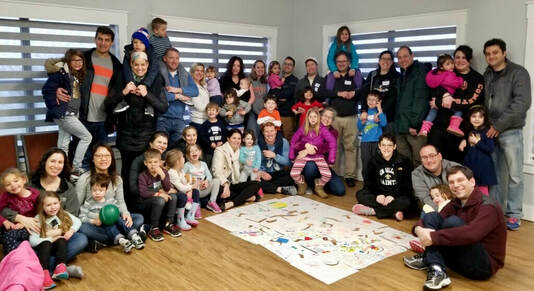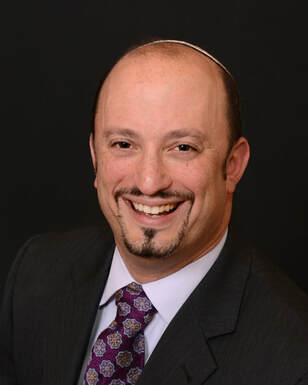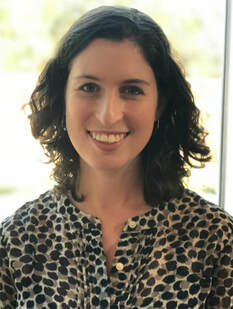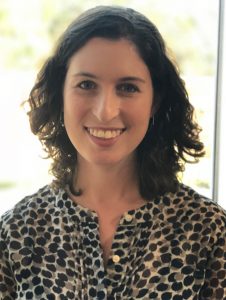 By Rabbi Shira Wallach The weather outside may have been frightful, but inside we made the best of it! This weekend, our most adventurous families made their way to Waxahachie to brave the cold, the wind, and the rain, so that we could experience a beautiful Shabbat together. I want to give you a couple of glimpses into the sacred time that we shared. On Friday night, Rabbi Roffman led his annual Bibliodrama session, in which he takes a beloved story from the Torah and allows parents and children to work together in order to retell and understand it from new perspectives. The story that we tackled was that of sending Moses down the Nile: how did his mother feel? What was his sister thinking? Why did Pharaoh’s daughter rescue him? And at each meal after that, if you looked over at the kids’ area where they could play when they were done eating, you could see them continuing to work out the story. On Shabbat morning, after morning tefilla, Sarah Lipinsky led an exploration into the weekly parasha by asking our children: What is your favorite room in your house and why? Do you think God would also enjoy that kind of space? What kind of a home would you build for God on earth? And then, our children led their parents in thinking through beautiful spaces for God. Some of their creations even boasted bounce houses, swimming pools, fully-equipped kitchens, lovely strings of lanterns, and glimmering jewels. On Saturday night, as we watched the sky grow dark, the temperature dropped and rain threatened. We sang a beautiful Havdalah inside, and then, most of us threw caution to the wind and went outside to toast marshmallows and enjoy the delicious nostalgia of s’mores. In the end, the crackling campfire and sheltering trees protected us from the elements. Back inside, we sang everything from “Brown-Eyed Girl” to “Twinkle Twinkle Little Star,” “Let it Go” to “Sweet Caroline.” In the morning, I asked families to talk about what they’d like to bring back to Dallas from the weekend, and then illustrate it on a large puzzle piece. Of course, we all loved the campfire, the music, and the company, but I also saw sketches of God’s house that the kids designed, Sarah’s incredible indoor obstacle course, a deck of UNO cards, and even one of the Shabbat-o-grams that we exchanged at the beginning of the weekend. You can see our assembled puzzle in the group photo; come by our offices soon to see the final laminated image! I want to thank our volunteer team Rachel Alexander, Shari Birnbaum, Amanda Franklin, Melissa Goldberg, and Julie Yochananov, and of course, none of this would be possible without the incredible Sarah Katz! Thank you to everyone who came, who helped create the special bonding and memories that will continue giving us joy. Let’s do it again next year! Much love, Rabbi Wallach
0 Comments
 Sermon--Parashat Terumah 5779 Tiny Treasures Shabbat, 2/9/19 by Rabbi Ari Sunshine According to a teaching of Rabbi Elazar Ha-Kappar in Pirke Avot (4:22), the Ethics of our Fathers, a collection of rabbinic wisdom and maxims included in the Mishnah some 1800 years ago, when we are born, we are actually born into the world against our will. Which is to say that no one consulted with us or asked our opinion before our arrival on this earth. And, moreover, we were also born into a world that had already benefited and suffered many times over because of choices our predecessors had made for us. We had no say in the matter of where our parents lived, how they made their living, whether they were compatible, or whether they provided us with food, clothing and shelter, even though every one of these factors had an impact on our lives when we began to live them. This idea that our world and some of our options and circumstances have already been shaped and constrained by decisions others have made seems to run counter to our society’s insistence that a persistent individual can determine his or her own destiny. While it’s true that there is certainly much that we can accomplish owing to our own individual initiative, we are also enmeshed in a larger context that is not of our own creation or doing that impacts our lives. In that way, we are often dependent on the foresight of those who came before us, in much the same way that our children will ultimately face the consequences or reap the benefits of the choices we make—or don’t make—today. This week’s parasha, Terumah, speaks to this interconnection of the generations quite clearly through an interesting and surprising detail we encounter in the parasha. In the early stages of the Israelites’ wandering through the Sinai wilderness, God instructs them to gather material with which to build the Mishkan, the portable Tabernacle that will serve as the symbolic home for God’s presence in their midst. Among the specific materials listed in Shemot, Exodus 25:4-5, we find “gold and silver and brass, and blue and purple and scarlet yarn, and fine linen and goats’ hair, and skins of rams dyed red, and skins of seals, and acacia wood.” While I realize too much goats’ hair might have required the invention of the world’s first lint brush, it’s not the inclusion of the goats’ hair that particularly puzzled the rabbinic sages. Rather, it is the mention of the atzei shittim, the acacia wood. Rashi, in his 11th century commentary, asks the obvious question, “From where did they obtain this in the wilderness?" After all, there are no acacia trees in the desert! How could God expect the Israelites to be able to obtain this type of lumber? Gersonides, the 14th century French philosopher and commentator also known by the acronym Ralbag, suggests that the Israelites might have cut down this wood in one of the places they passed through on the way in order to make furniture, and now donated whatever of it they had for the purpose of constructing the Mishkan. Don Isaac Abarbanel, the 15th century Portuguese commentator, explained the disconnect by noting that most probably this wood, like the oil and spices, was purchased from the neighboring peoples who came to the Israelite camp to sell things. But Rashi in his day offered up a different explanation, which he brought from the Midrash Tanhuma, which was that our patriarch Jacob prophesized through God’s Divine Spirit that his descendants the Israelites would one day build the Tabernacle in the wilderness. So Jacob brought cedars—he believed the acacia was a kind of cedar—down to Egypt with him, planted them, and instructed his children to take them along when they left. According to Rashi’s answer, our ancestor Jacob showed foresight and anticipated the needs of a future generation and then went out of his way to plan for and provide for those needs. He did not personally have any need for cedars or acacia wood, nor did he personally reap any benefit from them. Moreover, schlepping wood and trees along may have seemed like an unnecessary encumbrance to his family and contemporaries. Yet Jacob knew that his descendants would need it—and for a sacred purpose, no less—so he went the extra mile to provide it for them. This kind of selflessness and foresight is not always common, so it’s not surprising to see that the Midrash attributes Jacob’s foresight to ruach ha-kodesh, Divinely inspired prophecy. In a similar vein, some of us may be familiar with the oft-cited Talmudic legend of Honi ha-m’agel, Honi the circle maker, and the story of his encounter with a man planting a carob tree. Honi asks the man how long it takes for the tree to bear fruit, to which the man replies, “70 years." Honi, puzzled by this response and thus the seemingly illogical action this man is taking, asks further, “So, are you sure you’ll be living for another 70 years?” And to this inquiry, the man responds, “I found a world full of carob trees. Just as my ancestors planted for me, so I plant for my children.” Honi then sits down to a meal, finishes eating, gets tired, and falls asleep for 70 years—according to the legend, no one found him in all that time because a rock formation grew around him and hid him from view. When he finally wakes up, sure enough, he sees a carob tree near him and a man picking fruit from the tree, prompting Honi to ask the man if he was the one who planted the tree. The man informed Honi that he was, in fact, the man’s grandson, to which Honi replies that now he knows he must have slept for 70 years. (Babylonian Talmud, Tractate Ta’anit 23a) In our own day and age, there are multiple parallels to Rashi’s midrashic explanation for how the Israelites obtained the acacia wood cited in our parasha and the Talmudic story of Honi and the man who planted the carob tree. First of all, the unnamed man in the story planted a carob tree so that his grandchildren and great-grandchildren would have fruit in their lifetime, and Jacob planted trees that his children would need some 400 years later. Thus, like Jacob in the midrash and the concerned carob-tree planter in the story, it is important that we remember to measure our choices and actions by their consequences that extend forward multiple generations hence, not just by our short-term wants and needs. This approach most certainly applies to taking care of our society, our environment, and our planet. But this parallel is also apt for Judaism and our Jewish communities. Specifically, when we “build” our own Judaism and our synagogue communities, we need to be forward thinking and not reactive, avoiding the trap that I know I’ve paraphrased here before in the name of Rabbi Ed Feinstein—one of the rabbis here at Shearith back in the day--that American Jews are really good at building synagogues that their parents and grandparents would have loved. We have an unfortunate habit in the modern Jewish world of either looking backwards at “glory days” gone by or being content to tread water in the present. We should be satisfied with neither if we are really intent on creating a vibrant Jewish future. Yet it is important to note in this vein something that we also often lose sight of: our children and grandchildren can only inherit what we ourselves possess. If we don’t plant and cultivate nourishing trees of life, as it were, meaningful Jewish experiences for ourselves that engage and inspire us regularly through the weeks of our year, then what exactly are we passing on to our children and grandchildren? We want to bestow on them values and guidance that will help them in their Jewish journeys when they are ready, and Jewish memories they would want to hold on to and cherish like a treasured possession. So this is the challenge we face, the delicate balance we must strive for: creating a living and evolving Judaism and synagogues and Jewish communities that both resonate with us AND will resonate with our children and grandchildren. And this week, and today in particular, we are witness to the nexus of this balance, with the presentation of Shearith’s Strategic Plan, “Ma’alot: Ascending New Heights” and our celebration in a few minutes of our Tiny Treasures, many of the new babies who have been born in our Shearith community during these last 12 months. The general focus of Ma’alot is to push us to build on the solid foundation we have already established at Shearith and move forward and upwards from here in all the broad areas of our congregational life and culture, inviting more participation and engagement and inspiring others to join in and rally around our mission, vision and values. This upward push towards creating an even more sacred community than the one we are already part of means involvement of all demographics in our congregation, from our eldest seniors, even 101 year old Alex Jonas who recently told his son Hylton how excited he was to see how much was going on at the shul, all the way down to our littlest babies and their families who we’ll be welcoming into the sanctuary momentarily. And, regardless of what demographic each of us fits into, it is these beautiful little babies and their sweet faces—well, when they’re not crying, anyway :) —that remind us what is at stake in the long run with the work we’re doing. We want these Tiny Treasures—our tiny treasures—to treasure the Judaism and the community that we are building and re-shaping for us and for them—and then, one day, to have that same foresight as our ancestor Jacob and the carob tree planter did and bequeath a compelling legacy, mission, and framework for living to their children and grandchildren. This is the holy responsibility we are holding in our hands at this crossroads. May we be worthy stewards of our tradition and our congregation for ourselves and for the generations who will follow us. AMEN.  by Rabbi Shira Wallach This past Shabbat, we welcomed our new class of Tiny Treasures—babies born in the year 2018—and their families into the warm and loving embrace of the Shearith Israel family. If you were there, thank you for helping us create such a wonderful space in which to share in the simcha of new life.  By Rabbi Shira Wallach Shabbat teaches us to create a palace in time; each week, once we tend to the required creation and work, we are rewarded with a whole day to celebrate, renew, and rest. But how often do our weekends allow us to access this ideal? Sometimes, it becomes necessary to build additional levels of intentionality and purpose into our Shabbat planning. And furthermore, sometimes it becomes necessary to seek out a new space, away from the hubbub of everyday life, to explore and reboot our relationships with one another, with God, and with Shabbat. |
Details
AuthorsShearith Israel clergy, staff and congregants share Archives
April 2023
Categories
All
|

 RSS Feed
RSS Feed